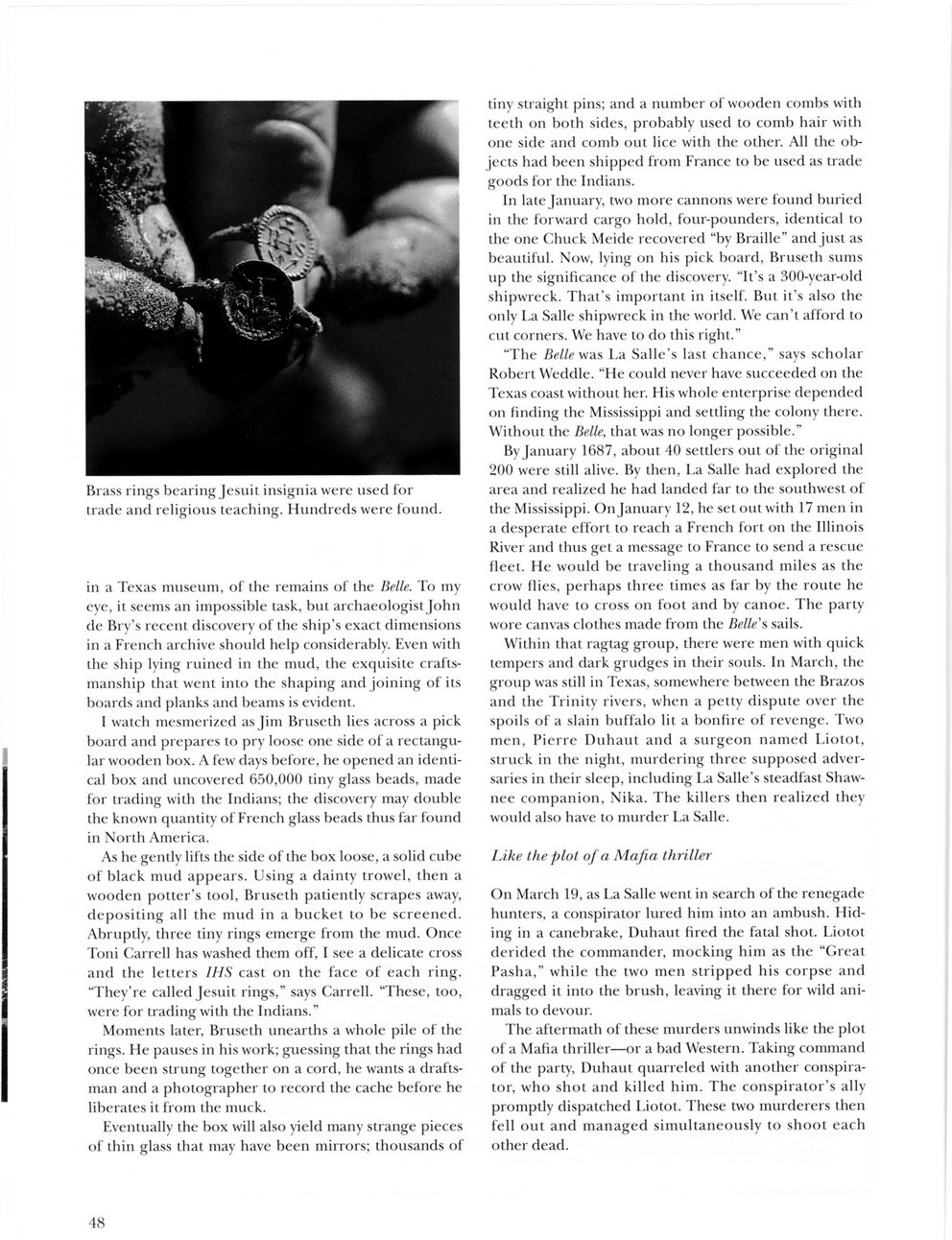This text was obtained via automated optical character recognition.
It has not been edited and may therefore contain several errors.
Brass rings bearing Jesuit insignia were used for trade and religious teaching. Hundreds were found. in a Texas museum, of the remains of the Belle. To my eye, it seems an impossible task, but archaeologist John de Bry?s recent discovery of the ship?s exact dimensions in a French archive should help considerably. Even with the ship lying ruined in the mud, the exquisite craftsmanship that went into the shaping and joining of its boards and planks and beams is evident. I watch mesmerized as Jim Bruseth lies across a pick board and prepares to pry loose one side of a rectangular wooden box. A few days before, he opened an identical box and uncovered 650,000 tiny glass beads, made for trading with the Indians; the discovery may double the known quantity of French glass beads thus far found in North America. As he gently lifts the side of the box loose, a solid cube of black mud appears. Using a dainty trowel, then a wooden potter?s tool, Bruseth patiently scrapes away, depositing all the mud in a bucket to be screened. Abruptly, three tiny rings emerge from the mud. Once Toni Carrell has washed them off, I see a delicate cross and the letters IMS cast on the face of each ring. ?They?re called Jesuit rings,? says Carrell. ?These, too, were for trading with the Indians.? Moments later, Bruseth unearths a whole pile of the rings. He pauses in his work; guessing that the rings had once been strung together on a cord, he wants a draftsman and a photographer to record the cache before he liberates it from the muck. Eventually the box will also yield many strange pieces of thin glass that may have been mirrors; thousands of tiny straight pins; and a number of wooden combs with teeth on both sides, probably used to comb hair with one side and comb out lice with the other. All the objects had been shipped from France to be used as trade goods for the Indians. In late January, two more cannons were found buried in the forward cargo hold, four-pounders, identical to the one Chuck Meide recovered ?by Braille? and just as beautiful. Now, lying on his pick board, Bruseth sums up the significance of the discovery. ?It?s a 300-year-old shipwreck. That?s important in itself. But it?s also the only La Salle shipwreck in the world. We can?t afford to cut corners. We have to do this right.? ?The Belle was La Salle?s last chance,? says scholar Robert Weddle. ?I le could never have succeeded on the Texas coast without her. His whole enterprise depended on finding the Mississippi and settling the colony there. Without the Belle, that was 110 longer possible.? Bv January 1687, about 40 settlers out of the original ?200 were still alive. By then, La Salle had explored the area and realized he had landed far to the southwest of the Mississippi. On January 12, he set out with 17 men in a desperate effort to reach a French fort 011 the Illinois River and thus get a message to France to send a rescue fleet. He would be traveling a thousand miles as the crow flies, perhaps three times as far by the route he would have to cross on foot and by canoe. The party wore canvas clothes made from the Belle's sails. Within that ragtag group, there were men with quick tempers and dark grudges in their souls. In March, the group was still in Texas, somewhere between the Brazos and the Trinity rivers, when a petty dispute over the spoils of a slain buffalo lit a bonfire of revenge. Two men, Pierre Duhaut and a surgeon named Liotot, struck in the night, murdering three supposed adversaries in their sleep, including La Salle?s steadfast Shawnee companion, Nika. The killers then realized they would also have to murder La Salle. Like the plot of a Mafia thriller On March 19, as La Salle went in search of the renegade hunters, a conspirator lured him into an ambush. Hiding in a canebrake, Duhaut fired the fatal shot. Liotot derided the commander, mocking him as the ?Great Pasha,? while the two men stripped his corpse and dragged it into the brush, leaving it there for wild animals to devour. The aftermath of these murders unwinds like the plot of a Mafia thriller?or a bad Western. Taking command of the party, Duhaut quarreled with another conspirator, who shot and killed him. The conspirator?s ally promptly dispatched Liotot. These two murderers then fell out and managed simultaneously to shoot each other dead. 48

LaSalle 007